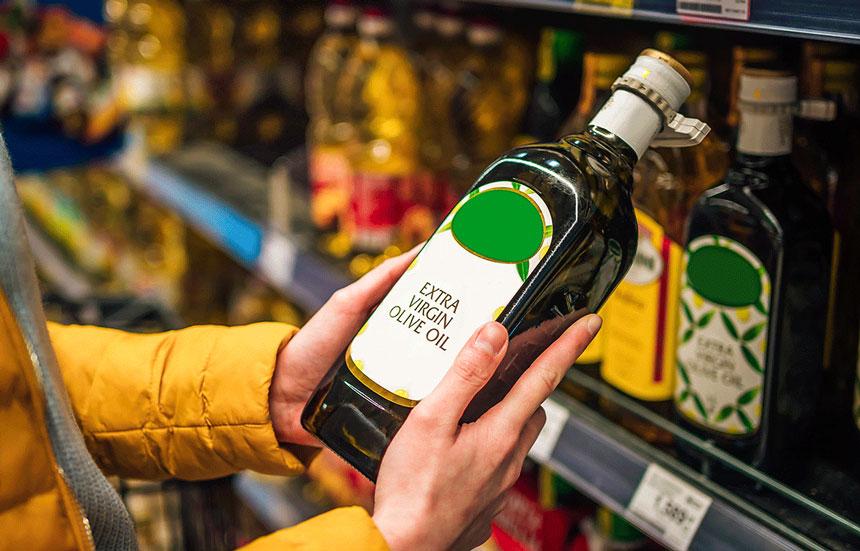3 Tips for Buying Olive Oil

You may have noticed how big the olive oil section of your supermarket has become. Olive oil consumption almost doubled from 1990 to 2021 and brands are offering olive oil at different price points and styles to keep up with the demand.
Its popularity as a cooking oil began taking off in the 1980s after studies linked it to health benefits. It’s also a well-known as a staple of the Mediterranean diet -- one of the healthiest eating styles.
But the overwhelming number varieties of olive oil can make it difficult to select the one that’s most appropriate for you. Here are some tips to make buying olive oil easier.
Different Types of Olive Oil
Here are the five basic types of olive oils in order of quality.
Extra-virgin olive oil. This is an unrefined oil and considered to be the gold standard of olive oils. It’s produced by cold-pressing olives to extract oil. This mechanical method of extraction creates a more nutrient-dense oil compared to other methods like heat or chemical extractions.
Extra-virgin olive oil has very high levels of a compound that help lower cholesterol, inflammation, blood pressure and the risk for heart disease. It also has anti-inflammatory, antioxidants and anti-microbial properties and is a modest source of vitamins E and K.
It has a very low acidity rate, less than 0.8 percent. The highest quality olive oils have an acidity level lower than 0.3 percent. Lower acidity means fewer free fatty acids and more monounsaturated fats, which studies link to lowering bad cholesterol.
Extra-virgin olive oil can vary in color, aroma and flavor based on when it’s harvested. Generally, its color ranges from green to gold; its aroma can be mild or bold and peppery; and flavor spans from grassy and artichoke-like to fruity. To maintain the quality of extra virgin olive oil, it must undergo a certification process that involves chemical analysis and sensory analysis to make sure it does not have any flavor defects, such as rancidity. Here is a list of olive oils certified by the North American Olive Oil Association as extra-virgin.
Common uses: lower-heat cooking, baking and sautéing – its smoke point ranges between 374- and 405-degrees Fahrenheit. It also can be used in salad dressings and dipping and finishing oils.
Virgin olive oil. This is an unrefined oil also produced by cold-pressing olives to extract oil. This is why virgin olive oil has similar health benefits as extra virgin olive oil and is a good source of many of the same nutrients. But there are a few differences.
Virgin olive oil goes through a degradation process when green olives are harvested, slightly raising the acidity of the oil by one to four percent. Olive oil with a higher acidic level is generally less healthy because acidity suggests a higher number of damaged olives were used to make the oil and the oil has fewer free fatty acids. Virgin olive oil also is less strict with allowance of minor flavor defects and lacks a defined range of oil aromas, colors and flavors. Despite it being a healthy option, it’s difficult to find. Many local grocery stores don’t carry it.
Common uses: lower-heat cooking, baking and sautéing – as its smoke point is only 410 degrees Fahrenheit. It also can be used in salad dressings.
Classic, pure or regular olive oil. This is a refined oil of lower quality. It’s made when the oil extraction process produces oil that’s poorer in quality than expected. It’s heated and/or treated with chemicals to control flavor defects. But some nutrients are lost in the process.
The oil also is blended with either virgin or extra-virgin olive oil to improve the quality, making an oil that’s 15 to 25 percent virgin olive oil. Regular olive oil tends to be lighter in color and have a neutral aroma. It’s commonly found on supermarket shelves, often labeled as “olive oil”.
Common uses: as a base for massage, herbal and infused oils. It also can be used for cooking. It has a smoke point around 470 degrees Fahrenheit, so it can be used for sautéing, roasting, baking, searing, grilling and frying.
Light and Extra-Light or Olive Pomace. This is a refined oil and the lowest quality available. It is extracted from the oil and water residue that remains after the fruit has been pressed and treated with heat and chemicals to correct flavor defects. Nutrients are often lost during the process, rendering it a lower quality oil.
To raise quality, it’s blended with virgin olive oil. But since the composition of the oil is only 5 to 10 percent virgin olive oil, the overall quality is still low. Some consumers see the terms light and extra-light and think the oil has fewer calories and fat grams. However, light and extra-light refer to the oil’s flavor and aroma. Light and extra-light olive oil has the same number of calories and fat grams as other olive oils. There are three grades of light and extra-light olive oil in the U.S. — olive-pomace oil, refined olive-pomace oil and crude olive-pomace oil (not suitable for consumption).
Common uses: crude olive-pomace oils can be used for cleaning and polishing furniture, as a basis for skincare and haircare products. You can cook with olive-pomace and refined olive-pomace oils, as they have a smoke point around 470 degrees Fahrenheit, making it useful for sautéing, roasting, searing, grilling, frying and baking in recipes that you don’t want an olive flavor. Many people also use it for deep frying.
Tips for Buying Olive Oil
Decide the purpose for using olive oil. If you’re trying to maximize health benefits from your cooking oil, then extra-virgin is your choice. However, if you’re looking for a healthy oil for your deep fryer, consider light or extra-light.
- Decide the purpose for using olive oil. If you’re trying to maximize health benefits from your cooking oil, then extra-virgin is your choice. However, if you’re looking for a healthy oil for your deep fryer, consider light or extra-light.
- Invest in higher quality. When buying extra-virgin olive oil, make sure it’s certified. by the North American Olive Oil Association. Another indicator of quality of country of origin on the label. Many countries produce high quality olive oils. The top olive oil countries include Italy, Spain and Greece; however, Croatia and Turkey also have been credited with producing the highest quality oils. Finally, don’t rely on color to determine quality. Colors vary too much.
- Look for a best-by and/or harvest date. Generally, olive oil is good for two years after bottling. You also should purchase a bottle size that enables you to finish the bottle within three months of opening it. The compounds in the oil begin degrading once they’re exposed to heat, oxygen and light.
If you’re considering cooking with extra-virgin olive oil for heart health, make sure you loop in your primary care physician. They can help discuss many other heart health strategies with you. Don’t have a primary care physician? Consider joining an MDVIP-affiliated practice. MDVIP-affiliated physicians have more time to help you in your pursuit of a healthier lifestyle. Find a physician near you and begin your partnership in health »


